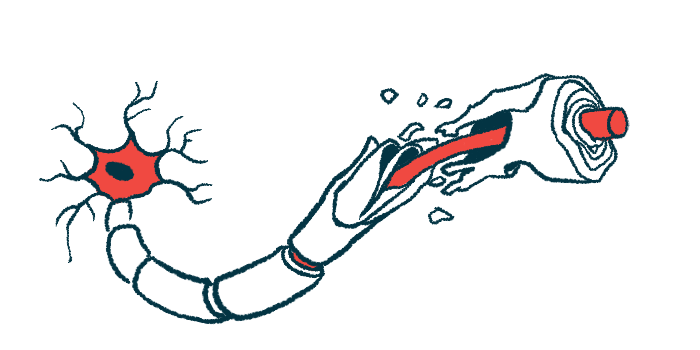Edaravone Shows Promise in Cells, Mice, in Restoring Myelin in NMOSD
ALS therapy found to improve motor function in NMOSD mouse models

The approved therapy Edaravone, used for amyotrophic lateral sclerosis (ALS) and stroke, may be a promising treatment for neuromyelitis optica spectrum disorder (NMOSD), according to a new study.
The use of edaravone in NMOSD cell and mouse models promoted restoration of the myelin sheath — damaged in immune attacks in the autoimmune disease — and improved motor function in mice.
These improvements were thought to be mediated by the activation of a signaling pathway called mTORC1.
The findings overall suggest that edaravone “represents a rational therapeutic agent for NMOSD patients,” the researchers wrote.
“[Edaravone] has been approved for clinical use by the FDA; hence, [edaravone] may be used as a therapeutic for NMOSD and other demyelinating diseases,” the team wrote.
The study, “Remyelination in neuromyelitis optica spectrum disorder is promoted by edaravone through mTORC1 signaling activation,” was published in the journal Glia.
NMOSD is marked by self-reactive immune system attacks that primarily affect the spinal cord and the optic nerve, which connects the eyes to the brain. In about 70% of cases, the antibodies that launch these attacks target the aquaporin-4 (AQP4) protein that resides on nervous system support cells called astrocytes.
As a consequence of these autoimmune attacks, there is a significant loss of myelin — the protective layer that surrounds and protects nerve cells and helps speed cell-to-cell communication — leading to key disruptions in nerve cell function.
To date, however, there are no available therapies for NMOSD that aim to restore myelin. That may be due, in part, to a lack of understanding about the mechanisms of myelin repair in the body, according to researchers.
Investigating edaravone for NMOSD
Normally, myelin in the brain and spinal cord is produced by oligodendrocytes, which are formed when precursor cells called oligodendrocyte progenitor cells (OPCs) differentiate into mature oligodendrocytes.
“Targeting the differentiation of OPCs to produce mature myelinating [oligodendrocytes] to restore myelin sheaths is critical for NMOSD treatment,” the researchers wrote.
To learn more, the researchers screened a number of compounds with the potential for myelin restoration in cell cultures of mouse OPCs. They found that edaravone could promote OPC differentiation into oligodendrocytes without signs of toxicity.
In the rest of their study, the team focused on better understanding the potential role of edaravone as a treatment for NMOSD.
Marketed as Radicava, edaravone is approved by the U.S. Food and Drug Administration (FDA) for the treatment of ALS. It has anti-inflammatory, antioxidant, and neuroprotective effects, and evidence has suggested it has an ability to promote OPC differentiation and remyelination.
The researchers evaluated edaravone’s ability to ease myelin loss in the brain and spinal cord of both cell culture and mouse models of NMOSD.
Altogether, the findings indicated that edaravone could significantly reduce myelin loss, even when administered after damage had already accumulated. These results suggest that edaravone can promote the restoration of lost myelin after injury rather than only being able to prevent its loss in the first place.
More mature oligoendrocytes and fewer undifferentiated OPCs also were observed in the mice after edaravone use.
The treatment also led to significant improvements in motor function in a mouse model of NMOSD, helping to reduce deficits in stride length and motor coordination normally observed in the model.
Across experiments, edaravone showed a limited ability to prevent astrocyte damage and ease inflammation.
In cell cultures of OPCs, the researchers identified a mechanism by which edaravone might promote remyelination. They found that the mTORC1 signaling pathway was enhanced with treatment, particularly in OPCs that had not yet differentiated into oligodendrocytes.
In the NMOSD mouse model and brain tissue from two NMOSD patients, mTORC1 signaling molecules were at lower-than-normal levels. In the mouse model, this was reversed with edaravone treatment.
Further, inhibiting mTORC1 signaling in OPC cell cultures with a drug called rapamycin markedly diminished the beneficial effects of edaravone on myelination. Treatment with NV-5138, which activates mTORC1, promoted OPC differentiation and enhanced myelination.
The findings overall support “the feasibility of a remyelination approach as an effective intervention for NMOSD,” the researchers wrote. More specifically, the data back the hypothesis that “direct activation of mTORC1 signaling by [edaravone] has potential as a novel therapeutic agent for the treatment of NMOSD.”






